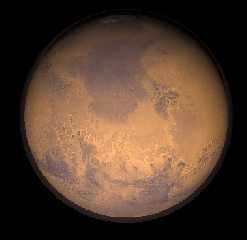 |
 |
|
 |
|
 |
|  |
|  |
|
 |
|
 |
|  |
|  |
|
 |
Here's my picture of Mars. It's just a sphere with an image mapped on to
it. Anyone know how I can get the atmosphere better? Thanks
David
#include "colors.inc"
#include "shapes.inc"
#include "finish.inc"
#include "glass.inc"
#include "metals.inc"
#include "stones.inc"
#include "woods.inc"
camera {
location <-1,4,10>
look_at <0,2,2>
}
light_source {
<-1,0,20>
colour <1,1,1>
}
sphere {
<0,0,0>, 2
pigment {
image_map {
tga "mars.tga"
map_type 1
once
}
rotate <-20,120,-20>
}
translate <0,2,2>
finish { diffuse 1 }
}
sphere {
<0,0,0>, 2.1
pigment {
color rgbt <1, 0.7, 0.7, 0.95>
}
translate <0,2,2>
finish { diffuse 5 }
}
Post a reply to this message
Attachments:
Download 'mars.jpg' (29 KB)
Preview of image 'mars.jpg'

|
 |
|  |
|  |
|
 |
|
 |
|  |
|  |
|
 |
David Findlay <dav### [at] yahoo com com au> wrote in news:3c0842f4
@news.povray.org:
> Anyone know how I can get the atmosphere better?
Use a spherical media that's about 0.02% larger than the planet. For extra
realism use an exponential falloff function.
Things get much harder if you want clouds. Multiple density is generally
the best way to go. au> wrote in news:3c0842f4
@news.povray.org:
> Anyone know how I can get the atmosphere better?
Use a spherical media that's about 0.02% larger than the planet. For extra
realism use an exponential falloff function.
Things get much harder if you want clouds. Multiple density is generally
the best way to go.
Post a reply to this message
|
 |
|  |
|  |
|
 |
|
 |
|  |
|  |
|
 |
Planetary renders, as simple as they may seem are always very cool. You can
achieve a realistic atmosphere using scattering media with a spherical
density (so the air thins the farther it gets from the planet). Perhaps
something like this:
-- POV 3.5 source
sphere {
<0,0,0>, 2.1
pigment {
color rgbt 1
}
interior {
media {
scattering {2, <1, 0.7, 0.7>*1 extinction 1 }
density { spherical }
}
}
translate <0,2,2>
hollow
}
--
Skip
David Findlay <dav### [at] yahoo com com au> wrote in message
news:3c0842f4@news.povray.org...
> Here's my picture of Mars. It's just a sphere with an image mapped on to
> it. Anyone know how I can get the atmosphere better? Thanks
>
> David
>
> #include "colors.inc"
> #include "shapes.inc"
> #include "finish.inc"
> #include "glass.inc"
> #include "metals.inc"
> #include "stones.inc"
> #include "woods.inc"
>
> camera
> location <-1,4,10>
> look_at <0,2,2>
> }
>
> light_source {
> <-1,0,20>
> colour <1,1,1>
> }
>
> sphere {
> <0,0,0>, 2
> pigment
> image_map {
> tga "mars.tga"
> map_type 1
> once
> }
> rotate <-20,120,-20>
> }
> translate <0,2,2>
> finish { diffuse 1 }
> }
>
> sphere {
> <0,0,0>, 2.1
> pigment {
> color rgbt <1, 0.7, 0.7, 0.95>
> }
> translate <0,2,2>
> finish { diffuse 5 }
> } au> wrote in message
news:3c0842f4@news.povray.org...
> Here's my picture of Mars. It's just a sphere with an image mapped on to
> it. Anyone know how I can get the atmosphere better? Thanks
>
> David
>
> #include "colors.inc"
> #include "shapes.inc"
> #include "finish.inc"
> #include "glass.inc"
> #include "metals.inc"
> #include "stones.inc"
> #include "woods.inc"
>
> camera
> location <-1,4,10>
> look_at <0,2,2>
> }
>
> light_source {
> <-1,0,20>
> colour <1,1,1>
> }
>
> sphere {
> <0,0,0>, 2
> pigment
> image_map {
> tga "mars.tga"
> map_type 1
> once
> }
> rotate <-20,120,-20>
> }
> translate <0,2,2>
> finish { diffuse 1 }
> }
>
> sphere {
> <0,0,0>, 2.1
> pigment {
> color rgbt <1, 0.7, 0.7, 0.95>
> }
> translate <0,2,2>
> finish { diffuse 5 }
> }
Post a reply to this message
|
 |
|  |
|  |
|
 |
|
 |
|  |
|  |
|
 |
I *might* be wrong, but I think at this distance the atmosphere wouldn't
visibly extrude from the side of the planet. The atmosphere is already taken
into account in the image map. I don't think you really need to worry about
adding extra atmosphere.
- Slime
[ http://www.slimeland.com/ ]
[ http://www.slimeland.com/images/ ]
Post a reply to this message
|
 |
|  |
|  |
|
 |
|
 |
|  |
|
 |




![]()